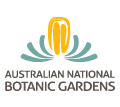 |
In Flower This WeekA weekly news-sheet prepared by a Gardens volunteerNumbers in brackets [ ] refer to garden bed 'Sections'. Plants in flower are in bold type. |
 |
In Flower This WeekA weekly news-sheet prepared by a Gardens volunteerNumbers in brackets [ ] refer to garden bed 'Sections'. Plants in flower are in bold type. |
9 November 2001
After admiring the flowers along Banks Walk, turn up the steps where there is a grouping of lovely white daisies, Helichrysum ‘Helping Hand’ [Section 210], the Floral Emblem of the International Year of Volunteers. This longer walk is to an area of colourful beauty where flowers and bird songs are so pleasant.
Edging the path along the Rainforest Gully verge, Tasmannia stipitata [Section 65] is a many-stemmed shrub with open clusters of small cream fluffy flowers. Acradenia euodiiformis [Section 65] has somewhat similar fragrant flowers over a small tree with dark shiny foliage. In front, branches of lavender flowers of Prostanthera caerulea [Section 214] arch over the road. Continue along this road to a group of grass trees, Xanthorrhoea glabra subsp. glabra [Section 61], all with gracefully flowing grassy skirts. Turn right, just before these plants, along a narrow mulched path which passes through an area of rhododendron cultivars, Rhododendron laetum x lochiae [Section 62]. The trumpet-like flowers are an attractive salmon-red colour. The perfume in this area is from the flowers of Lomandra longifolia [Section 62], a tussocky plant with long strappy leaves and spiny yellow flowers in flattened spikes. This path then joins the path across the gully and so to the road edging the far side of the Rainforest.
The deep purple hibiscus-like flowers of Alyogyne huegelii [Section 17] are quite showy, likewise the small shrub Pimelea spectabilis [Section 17], with large heads of white flowers with a tint of pink. Continue uphill to where Banksia spinulosa var. collina [Section 37B], with many golden flower heads, blends with a waratah hybrid, Telopea mongaensis x speciosissima [Section 37B], a taller shrub with attractive, open, scarlet flowers.
Turn at the Bottle Tree, Brachychiton rupestris [Section 42], past the field of purple pea flowers of the vine Kennedia retrorsa [Section 46]. Asterolasia hexapetala [Section 46] is a shrub with open white flowers, below which is Boronia fastigiata [Section 46] with mauve-pink flowers over a dwarf, dense shrub. Opposite, Phebalium squamulosum subsp. argenteum [Section 46] has clusters of furry white flowers and Boronia muelleri ‘Sunset Serenade’ [Section 46] is small and compact and laden with pink-white flowers. Behind, Boronia mollis ‘Lorne Pride’ [Section 46] is larger and rounded and a blaze of richer pink flowers. Down the next small path, Boronia tetrandra [Section 46] is dwarf and covered with yellow buds opening to bell-shaped perfumed flowers. Eriostemon buxifolius subsp. obovatus (now Philotheca buxifolia subsp. obovata) [Section 46] is a prostrate plant with lateral branches of white star flowers. As a backdrop, Boronia pinnata ‘Spring White’ [Section 46] is dense with open-petalled white flowers and Zieria granulata [Section 46] with clusters of small white flowers.
Along this path there is Boronia microphylla [Section 46], with dappled pink and white flowers, Boronia heterophylla [Section 46] ... and many others too, but take a seat and think of all this beauty with the chorus of so many birds...
A great section of the Gardens ... Barbara Daly.
| Return to: | Australian National Botanic Gardens | Previous
'In Flower' Weeks |